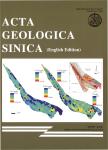Origin of Boron in the Gas Hure Salt Lake of Northwestern Qaidam Basin, China: Evidence from Hydrochemistry and Boron Isotopes
Origin of Boron in the Gas Hure Salt Lake of Northwestern Qaidam Basin, China: Evidence from Hydrochemistry and Boron Isotopes作者机构:Key Laboratory of Comprehensive and Highly Efficient Utilization of Salt Lake ResourcesQinghai Institute of Salt LakesChinese Academy of SciencesXining 810008China Qinghai Provincial Key Laboratory of Geology and Environment of Salt LakesXining 810008China Department of Earth SciencesKarakoram International UniversityGilgitGilgit-Baltistan 15100Pakistan State Key Laboratory of Biogeology and Environmental GeologyChina University of GeosciencesWuhan 430074China
出 版 物:《Acta Geologica Sinica(English Edition)》 (地质学报(英文版))
年 卷 期:2021年第95卷第2期
页 面:531-540页
核心收录:
学科分类:081803[工学-地质工程] 0709[理学-地质学] 0819[工学-矿业工程] 08[工学] 0818[工学-地质资源与地质工程] 0708[理学-地球物理学] 0816[工学-测绘科学与技术]
基 金:Financial support for this research was provided by the “Western Light” Fund of the Chinese Academy of Science Foundation (Y910061016) The National Natural Science Foundation of China (No. 42007169) The Key deployment projects of the Chinese academy of sciences (ZDRW-ZS-2020-3) Funds for the Natural Science Foundation of Qinghai Province (No. 2020-ZJ-932Q 2020-ZJ-732 2019-ZJ-7028)。
主 题:B-bearing rock weathering evaporation process Holocene Qinghai and Xinjiang provinces
摘 要:The Gas Hure Salt Lake(GHSL) in the northwestern Qaidam Basin, western China, is rich in boron(B) resources, but its B-resource origin is hardly known. Hydrochemical compositions and B isotope characteristics of different waters were collected around the GHSL, including the river water, stream water, spring water, salt-lake brine, intercrystalline brine, well water, drilling brine, and solar pond brine. The hydrochemical signatures suggest that silicates, carbonates and evaporates are the main B-bearing rocks during the water dynamic. The reservoir estimation of B resources shows that the Kulamulekesay River(KLMR) and the Atekan River(ATKR) contribute annually 18.3 tons and 22.84 tons of B, respectively, with a total amount of 11.72 × 10^(4) tons of B during the past 5.7 ka. In comparison with the known B reservoir(32.96 × 10^(4) tons) in the GHSL, a significant amount of B in the GHSL was probably recharged from deep fluids and sediments around the GHSL. The B concentration and B-enrichment degree are shaped by the evaporation process, which are highly elevated at the carnallite and bischofite stages.



